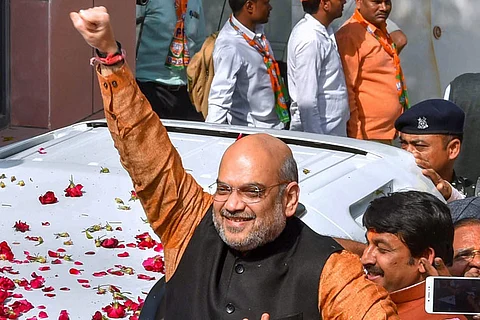

Anyone who has worked with Amit Shah will tell you ‘B’ is the most important alphabet in his dictionary. ‘B for Booth’ is the BJP president's mantra for success. And for every decision that Shah takes, he also keeps a Plan B. It was no different in Karnataka.
It was in August last year that the BJP started work to effect a turnaround in Karnataka. The morale was down after the twin losses in Nanjungud and Gundlupet, where BS Yeddyurappa elevated the stature of the byelections by campaigning extensively, calling them a referendum on the Siddaramaiah regime. The Chief Minister upped the game, deploying all the resources at his command in the two constituencies, winning both. In hindsight, the BJP admitted its strategy was a blunder and ended up providing momentum to the Congress.
Shah asked the Karnataka unit to launch the Vistarak programme under which every leader was asked to spend a fortnight in a different constituency. Each MLA also was given charge of another constituency that had not elected a BJP legislator while MPs were asked to take responsibility for two constituencies. The focus was on strengthening booth committees, contact key voters including seers and religious leaders, cooperative union leaders, advocates and self-help group members.
The booth committees were at the heart of the BJP's effort to capture power in Karnataka. Nine members took up the responsibility of every booth and an effort was made to reflect the caste matrix. Two women, two SC/STs, two OBCs figured in the nine-member booth committee. This was a huge army on the ground given that there are on an average 200 booths in every constituency though some like Mahadevpura on the outskirts of Bengaluru have over 500 booths. The booth committees reported to a leader who as part of a Shakti kendra, monitored the work done by every five booths.
This presence among the people was also used to gather information in every constituency about what the voters wanted. The information was used in the manifesto that was specific for individual constituencies. Manifesto conventions were organised in all 224 assembly constituencies, with up to 500 people who did not belong to the BJP, invited to make suggestions. This further reflected in the state-level manifesto that was prepared.
In order to target specific communities, the BJP also organised OBC, SC/ST, fishermen and farmer conventions. The farmer convention was organised in Davangere on Yeddyurappa's birthday on 27 February, where Prime Minister Narendra Modi was also present. After May 1, Modi addressed several groups over NaMo app, giving the final thrust to the clinically chalked out campaign.
Karnataka, by any yardstick, was a tough campaign. Though history suggested the state had not returned a party to power for a second consecutive term for the last three decades, the Congress had got its act together. It had rattled the BJP by announcing separate religion status for the Lingayats, in order to tempt a section of the votebank, otherwise committed to the BJP, to ditch it.
This meant Shah had to spend considerable time mutt-hopping, meeting seers to solicit support. He did not get the kind of reception he expected at all mutts, with many seers in favour of Siddaramaiah's decision. So, Shah's Plan B was to reach out directly to Lingayat groups, cutting through the religious wrapping. Using the power of WhatsApp, the BJP groups connected directly to every smartphone village in northern Karnataka which is Lingayat territory to tell people that Siddaramaiah was trying to divide Hindus.
The counter narrative was aided by the Sangh Parivar. The cadre of the RSS, VHP and Bajrang Dal was mobilised in large numbers to undertake a door-to-door campaign to tell the Lingayats in this belt that they needed to stick together. The success in Mumbai-Karnataka where it got 44% of the vote against 39% to the Congress showed the Lingayats had not deserted them in large numbers.
During the campaign, Rahul Gandhi accused the JD(S) of being the ‘B’ team of the BJP. In effect, it was the BJP that decided to be the ‘B’ team to the JD(S) in select constituencies, choosing to transfer votes in order to vanquish the Congress. It was most apparent in Chamundeshwari where once it realised it did not have a formidable candidate, it decided to tacitly support GT Deve Gowda. The strategy was a success, with Gowda crushing Siddaramaiah by 36000 votes.
Experienced leaders know the difference between a hired crowd and a more spontaneous reaction. Shah, like Narendra Modi, is a believer in the power of the optic. During his campaign, when his chopper was just taking off after a public meeting, he saw an elderly woman below, raising her hands to do a namaste.
“She would not have understood what I spoke at the meeting since I speak in Hindi. Her gesture was not even for me, it was for the BJP,” Shah was to tell BJP spokesperson Sambit Patra later. That to Shah, was the defining moment of the election when he was convinced the party would emerge as the single largest in the Assembly.
BJP MLA from Rajaji Nagar and former Law Minister Suresh Kumar revealed that during a closed- door meeting with BJP leaders in Bengaluru in March, Amit Shah gave them an option A and option B for the Karnataka unit.
“If you listen to me, follow my advice, you will become Uttar Pradesh. If you do not listen to me, do not follow my advice, you will become Goa,” he warned.
Shah was alluding to the clear majority in Lucknow contrasting it with the situation in Panjim where the BJP needed to cobble up a majority last year. With the party in a so-close-yet-so-far situation in Bengaluru, Shah would have realised his Karnataka colleagues chose Option B.